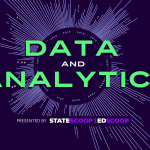Cities are getting better at reading between the numbers

City leaders have never held data in higher regard than they do now.
Two years of unceasing public and internal demand for accurate, easily understandable analysis of the COVID-19 pandemic has also sparked new programming around how data can address chronic issues — including equity in connectivity, housing, education and the environment. And though IT officials and tech-minded mayors say they’re getting pretty good at reading between the numbers to better understand their communities, there’s still plenty of room for cities to improve alongside rapidly changing technologies and stuck-in-their-ways agencies.
One major challenge cities can face is that they still struggle with “inaccessible” data, city leaders told StateScoop. In Irving, Texas, a 240,000 person city just north of Dallas, Chief Innovation and Performance Officer Aimee Kaslik said she plans to spend more time with departments on “getting good data,” which sometimes means reviewing old data.
“That section is where some projects can come to a halt because they aren’t collecting the data that they need or there are data quality issues, so we’ll spend a lot of time before a project launches on addressing those data quality needs, on putting together data collection plans in order to really help them move forward,” Kaslik said.
Irving plans to launch a data academy this month to advance its data-informed policymaking, she said. The academy involves Kaslik and her team training departments on advanced use of programs like Microsoft Excel. She said that although there are a lot of powerful data analysis tools available to city governments, “everybody has Excel. It’s completely accessible.” City staff will also learn to create data visualizations, enabling employees to tell stories with their data — whether they’re good or bad.
“You need to be able to see your strengths and see where you’re growing and improving, but to me, more importantly, you need to be able to quickly and visually see where you have opportunities to improve,” Kaslik said.
How the data flows
Instead of launching a data academy to improve data capacity and quality, Seattle uses a form of “project-based learning” to educate city employees on data, the city’s acting director of innovation and performance, Leah Tivoli, told StateScoop. On a project-by-project basis, Tivoli and her team plans to meet with departments — sometimes five days a week — to analyze data and to ensure city staff understand why it’s useful. Recently, she said, her team has been focused on coordinating services between several departments providing services to homeless residents.
“To do that project and be able to pull that data together across seven different departments in an automated fashion, we literally meet with people who collect data in the field every day,” Tivoli said. “We go through the transactional data together and people are beginning to learn, through this experience, how the data works, how it flows.”
Daily meetings on data collection and storage have led to breakthrough moments between Tivoli and other city staff, like explaining what “polygon” means in relation to geospatial data.
“I hadn’t even considered that that wasn’t a term that everyone uses, so it’s been this incredible opportunity for people to understand how the information that they tap into with these work management systems flows into a repository, and where they can see the information they put in. They know how to correct it now and how that tells the story of the work that we’re doing altogether across all these different departments,” she said.
The team also works with external partners to build out some data-informed projects. Working with Google’s charitable arm, Google.org, Tivoli’s team is designing a dashboard designed to streamline processing for city’s benefits applications. Tivoli said that technology is an integral part of how Mayor Bruce Harrell solves problems, but it’s not the whole answer.
“I think there’s this assumption that it’s all about technology, but it’s actually about data and data literacy and how to manipulate the information to make it work.”
Tivoli said that the city still faces several key challenges in its day-to-day efforts to incorporate data into its programming, starting with the quality and access to the data itself. Tivoli works with city departments to surface, organize and automate data to “take the effort out” of data-driven decision making, which might otherwise require manually poring over data to glean insights. To avoid unnecessary analysis, her team often focuses on analyzing data that’s “evergreen” or data that can be used for more than just one specific report.
“Naturally,” Tivoli said, “priorities shift in government.”
‘A culture problem’
To make working across departments easier, Tivoli said she emphasizes human-centered design and close relationships with the budget office and mayor’s office. In San Antonio, Texas, too, strong partnerships is where successful data-informed policymaking is born, said Emily Royall, the city’s smart city administrator.
“Fundamentally, without really building an architecture and an internal framework for how we actually manage and maintain data internally and make all of that data visible, shareable and accessible, across city departments, we can’t really build long-term systemic solutions to those big problems like transparency and smart cities,” Royall said. “Data powers all of those things, but we need to establish that strong structure for managing that internally. I think that is more of a culture problem than it is a technology problem.”
Royall said local governments have a tendency to launch “Band-Aid type projects” in response to new data sets or technologies, rather than developing long-term strategies. She said her team expects to be done training “data stewards” for every city department within a couple of years, after last year establishing a new data governance model and taking stock of staff members’ data literacy. But she said once a solid foundation in data analysis is established, adopting new data sets and technologies will be easier than ever.
“It’s super easy to fall into ‘let’s get that new flashy thing,'” said Matthew Reat, a performance excellence administrator at the San Antonio Office of Innovation. “Not to disparage the folks selling those solutions and software, but I think there’s a tendency because of that kind of work to sell everything as a panacea: ‘Just go buy this out of the box, man, we solve everything.’”
Data stewardship
Reat said one of the largest benefits of having a “robust” data program is being able to share with the city’s vendors specific, straightforward requirements for how San Antonio expects data to be created and delivered. To develop its data program, Reat and Royall asked each department to nominate between one and four data stewards to become data experts by participating in the city’s innovation academy.
Asking questions about whether each department classifies data, has an internal data sharing platform or data-privacy standards helps the academy organize its data stewards into cohorts. They’re also asked about what key services they provide and how data relates to those services. Kaslik, the Irving, Texas, official, said she now asks her fellow city agencies similar, pointed questions.
“It sounds harsh, but: ‘Why do you exist?’ From the customer perspective: ‘What is your purpose?’” Kaslik said. “We create purpose statements, figure out what are your key processes and what are you doing to achieve that purpose and work from there to identify metrics.”
There’s a reason multiple cities have adopted the data academy model as part of their long-term data governance strategies. Cities like to copy each other, Kaslik said, and national programs that reward good data governance — like Bloomberg Philanthropies’ What Works Cities program — incentivize civic technologists to share their best practices with each other. Since What Works Cities began certifying cities for their data-informed decision making in 2017, mayors and data officials have been striving to achieve the program’s top certification — “platinum” — for both the prestige and the technical assistance provided by Bloomberg Philanthropies. Fifty cities have been certified so far. And they’re in constant contact, Kaslik said.
“Cities are all about borrowing from one another. We just are,” she said. “So we look to see what others are succeeding at, so we reach out and go from there.”

This story was featured in StateScoop Special Report: Data and Analytics (2022)






